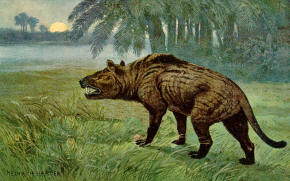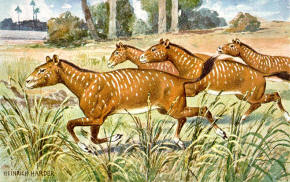The Oligocene is often considered an important time of transition, a link between "[the] archaic world of the tropical Eocene and the more modern-looking ecosystems of the Miocene." Major changes during the Oligocene included a global expansion of grasslands, and a regression of tropical broad leaf forests to the equatorial belt.
The start of the Oligocene is marked by a major extinction event, a faunal replacement of European with Asian fauna except for the endemic rodent and marsupial families called the Grande Coupure. The Oligocene-Miocene boundary is not set at an easily identified worldwide event but rather at regional boundaries between the warmer late Oligocene and the relatively cooler Miocene.
Climate
The Paleogene Period general temperature decline is interrupted by an Oligocene 7M-year stepwise climate change. A deeper 8.2oC 0.4M-year temperature depression leads the 2oC 7M-year stepwise climate change 33.5Ma. The stepwise climate spanned 7M-years 25.5Ma through 32.5Ma as depicted in the PaleoTemps chart. The Oligocene climate change was a global increase in ice volume and a 55m decrease in sea level (35.7-33.5Ma) with a closely related (25.5-32.5Ma) temperature depression. The 7M-year depression abruptly terminated within 1-2M-year of the La Garita Caldera volcanism event 28-26 Ma. A deep 400 k-year glaciating Oligocene Miocene boundary event is recorded at the McMurdo Sound and King George Island.
Paleogeography
During this period, the continents continued to drift toward their present positions. Antarctica continued to become more isolated and finally developed a permanent ice cap.
Mountain building in western North America continued, and the Alps started to rise in Europe as the African plate continued to push north into the Eurasian plate, isolating the remnants of the Tethys Sea. A brief marine incursion marks the early Oligocene in Europe. Oligocene marine exposures are rare in North America. There appears to have been a land bridge in the early Oligocene between North America and Europe since the faunas of the two regions are very similar. During sometime in the Oligocene, South America was finally detached from Antarctica and drifted north towards North America. It also allowed the Antarctic Circumpolar Current to flow, rapidly cooling the continent.
Flora
Angiosperms continued their expansion throughout the world; tropical and sub-tropical forests were replaced by temperate deciduous woodlands. Open plains and deserts became more common. Grasses expanded from the water-bank habitat in the Eocene and moved out into open tracts; however even at the end of the period it was not quite common enough for modern savanna.
In North America, subtropical species dominated with cashews and lychee trees present, and temperate trees such as roses, beech and pine were common. The legumes of the pea and bean family spread, and sedges, bulrushes and ferns continued their ascent.
Fauna
Important Oligocene land faunas are found on all continents at this time. Even more open landscapes allowed animals to grow to larger sizes than they had earlier in the
 |
| Above: Hyaenodon Below: Mesohippus |
 |
South America was isolated from the other continents and evolved a quite distinct fauna during the Oligocene, home to strange animals such as pyrotheres and astrapotheres, as well as litopterns and notoungulates. Sebecosuchian crocodiles, terror birds, and carnivorous marsupials like the borhyaenids remained the dominant predators. Brontotheres died out in the Earliest Oligocene, and creodonts died out outside Africa and the Middle East at the end of the period. Multituberculates, an ancient lineage of primitive mammals, also went extinct in the Oligocene. The Oligocene was home to a wide variety of strange mammals. A good example of this would be in the White River Badlands of the United States, which were formerly a semi-arid prairie home to many different types of endemic mammals, including entelodonts like Archaeotherium, camels (such as Poebrotherium), running rhinos, three-toed horses (such as Mesohippus), nimravids, protoceratids, and early dogs like Hesperocyon. Oreodonts, an endemic American group, were very diverse during this time. In Asia during the Oligocene, a group of running rhinos gave rise to the indricotheres, like Indricotherium, which were the largest land mammals ever to walk the Earth.
The marine animals of Oligocene oceans resembled today's fauna, such as the bivalves. The fossil record of marine mammals is a little spotty during this time, and not as well known as the Eocene or Miocene, but some fossils have been found. The baleen and toothed cetaceans (whales) just appeared, and their ancestors, the archaeocete cetaceans began to decrease in diversity due to their lack of echolocation, which was very useful as the water became colder and cloudier. Other factors to their decline could include climate changes and competition with today's modern cetaceans and the carcharhinid sharks, which also appeared in this epoch. Early desmostylians, like Behemotops, are known from the Oligocene. Pinnipeds (seals) probably appeared near the end of the epoch from a bear-like or otter-like ancestor.
End of Reading
Return to the Old Earth Ministries Online Earth History Curriculum homepage.
Source: Oligocene